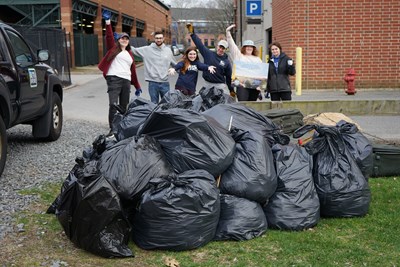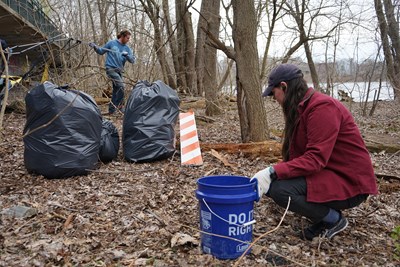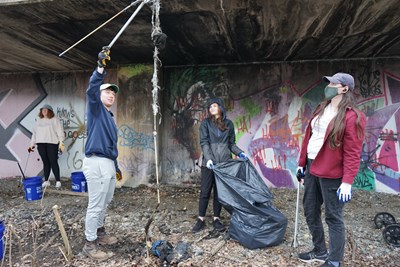UMass Lowell students and volunteers celebrate Earth Day with river cleanup
Two local organizations join UML's Society of Environmental Scientists for biannual event

Senior environmental science major Fiona Benzi strapped on a pair of heavy-duty gloves and got to work cleaning up the litter left on the riverbank behind Edward A. LeLacheur Park.
Benzi was among about a dozen students and volunteers who gathered for the Society of Environmental Scientists’ biannual river cleanup. Taking stock of the plastic bags, food wrappers and disposable wipes littering the area, Benzi was astonished by the amount of trash collected in just two hours – enough to fill more than 30 60-gallon bags.
“We were really productive,” says Benzi, who enlisted the help of Lowell Litter Krewe, a group focused on the redevelopment of underutilized open space, and Lowell’s Life Connection Center, a homeless outreach center. “It was really helpful having the two organizations here. They’re much more knowledgeable because they do this almost every day.”
Brad Buitenhuys, executive director of Lowell Litter Krewe, came prepared with buckets, bags, trash grabbers, heavy-duty gloves, a sharps container and an eagerness to help.

“If we’re out here in force, regularly caring for our city, then we instill the belief that this place is worth caring for,” he says. “It just needs a little bit of positive reinforcement and encouragement along the way. By getting it back to its natural state, we can remind people that it’s their responsibility to keep it that way.”
Since the days when it powered Lowell’s textile mills during the Industrial Revolution, the 115-mile Merrimack River has played a central role in the city. It currently provides drinking water for about a half million people in Lowell, Methuen, Andover, Tewksbury and Lawrence, according to the Environmental Protection Agency.
Keeping the banks clean along the river is crucial because any litter that enters the water can affect its quality, says Thomas Furtado, a senior environmental science major.
“If you were to go up to New Hampshire by Manchester, every time the river floods, it picks up all the plastic, and then it deposits around here, so it can become a big issue downstream,” he says.

Debris that ends up on the riverbanks in Lowell can make its way back into the river and eventually into the ocean.
“As Gill said in ‘Finding Nemo,’ all drains lead to the ocean,” says Lori Weeden, Environmental, Earth & Atmospheric Sciences associate teaching professor and SES advisor. “What runs off the banks of the Merrimack River in Lowell affects everything downstream and into the ocean. If we are to solve the ocean pollution issue, we need to cut the pollution off at the source. One of those sources is pollution runoff from rivers like the Merrimack.”
The Merrimack River’s water quality already faces residual impacts dating back to the 1800s. The canals of Lowell became polluted with trash and dyes as textile makers often dumped waste into the water, according to the National Park Service.
“These streams that previously had factories on them residually have contaminants in them that are terrible,” Benzi says. “In general, the river may look healthy and beautiful, but the water itself sometimes is not, and adding trash to it doesn’t help the situation.”
Lucia Cheney, a senior environmental science major, says hosting cleanup events like this can help encourage others to treat the riverbanks with respect.
“The cleanup shows at least somebody cares about the area,” she says. “You have people walking by the work that’s being done and they think, ‘Oh, they’re doing that. Maybe I should do something or maybe shift my actions.’”